1. Thompson BG, Brown RD Jr, Amin-Hanjani S, Broderick JP, Cockroft KM, Connolly ES Jr, et al. Guidelines for the management of patients with unruptured intracranial aneurysms: a guideline for healthcare professionals from the American Heart Association/American Stroke Association. Stroke. 2015; 46(8):2368–2400. PMID:
26089327.
2. Juvela S, Poussa K, Lehto H, Porras M. Natural history of unruptured intracranial aneurysms: a long-term follow-up study. Stroke. 2013; 44(9):2414–2421. PMID:
23868274.

3. Wiebers DO, Whisnant JP, Huston J 3rd, Meissner I, Brown RD Jr, Piepgras DG, et al. Unruptured intracranial aneurysms: natural history, clinical outcome, and risks of surgical and endovascular treatment. Lancet. 2003; 362(9378):103–110. PMID:
12867109.

4. United Nations, Department of Economic and Social Affairs, Population Division. World Population Prospects 2019: Highlights. New York, NY, USA: United Nations, Department of Economic and Social Affairs, Population Division;2019.
5. Lee SU, Kim T, Kwon OK, Bang JS, Ban SP, Byoun HS, et al. Trends in the incidence and treatment of cerebrovascular diseases in Korea: Part II. Cerebral infarction, cerebral arterial stenosis, and moyamoya disease. J Korean Neurosurg Soc. 2020; 63(1):69–79. PMID:
31064040.
6. Lee SU, Kim T, Kwon OK, Bang JS, Ban SP, Byoun HS, et al. Trends in the incidence and treatment of cerebrovascular diseases in Korea: Part I. Intracranial aneurysm, intracerebral hemorrhage, and arteriovenous malformation. J Korean Neurosurg Soc. 2020; 63(1):56–68. PMID:
31064041.
7. Vernooij MW, Ikram MA, Tanghe HL, Vincent AJ, Hofman A, Krestin GP, et al. Incidental findings on brain MRI in the general population. N Engl J Med. 2007; 357(18):1821–1828. PMID:
17978290.

8. Mahaney KB, Brown RD Jr, Meissner I, Piepgras DG, Huston J 3rd, Zhang J, et al. Age-related differences in unruptured intracranial aneurysms: 1-year outcomes. J Neurosurg. 2014; 121(5):1024–1038. PMID:
25170670.

9. Jalbert JJ, Isaacs AJ, Kamel H, Sedrakyan A. Clipping and coiling of unruptured intracranial aneurysms among medicare beneficiaries, 2000 to 2010. Stroke. 2015; 46(9):2452–2457. PMID:
26251248.

10. Bekelis K, Gottlieb DJ, Su Y, O'Malley AJ, Labropoulos N, Goodney P, et al. Comparison of clipping and coiling in elderly patients with unruptured cerebral aneurysms. J Neurosurg. 2017; 126(3):811–818. PMID:
27203150.

11. Brinjikji W, Rabinstein AA, Lanzino G, Kallmes DF, Cloft HJ. Effect of age on outcomes of treatment of unruptured cerebral aneurysms: a study of the National Inpatient Sample 2001–2008. Stroke. 2011; 42(5):1320–1324. PMID:
21441142.
12. Kwinta BM, Kliś KM, Krzyżewski RM, Wilk A, Dragan M, Grzywna E, et al. Elective management of unruptured intracranial aneurysms in elderly patients in a high-volume center. World Neurosurg. 2019; 126:e1343–51. PMID:
30898743.

13. Sturiale CL, Brinjikji W, Murad MH, Lanzino G. Endovascular treatment of intracranial aneurysms in elderly patients: a systematic review and meta-analysis. Stroke. 2013; 44(7):1897–1902. PMID:
23686977.
14. O'Neill AH, Chandra RV, Slater LA, Chong W, Xenos C, Danks AR, et al. Influence of comorbidities on treatment of unruptured intracranial aneurysms in the elderly. J Clin Neurosci. 2019; 62:38–45. PMID:
30655235.
15. Jung YJ, Ahn JS, Park ES, Kwon DH, Kwun BD, Kim CJ. Surgical results of unruptured intracranial aneurysms in the elderly: single center experience in the past ten years. J Korean Neurosurg Soc. 2011; 49(6):329–333. PMID:
21887389.
16. Oishi H, Yamamoto M, Nonaka S, Shimizu T, Yoshida K, Mitsuhashi T, et al. Treatment results of endosaccular coil embolization of asymptomatic unruptured intracranial aneurysms in elderly patients. J Neurointerv Surg. 2015; 7(9):660–665. PMID:
25034903.

17. Ikawa F, Michihata N, Akiyama Y, Iihara K, Matano F, Morita A, et al. Treatment risk for elderly patients with unruptured cerebral aneurysm from a nationwide database in Japan. World Neurosurg. 2019; 132:e89–98. PMID:
31518740.

18. Silva NA, Shao B, Sylvester MJ, Eloy JA, Gandhi CD. Unruptured aneurysms in the elderly: perioperative outcomes and cost analysis of endovascular coiling and surgical clipping. Neurosurg Focus. 2018; 44(5):E4.

19. Muramatsu N, Akiyama H. Japan: super-aging society preparing for the future. Gerontologist. 2011; 51(4):425–432. PMID:
21804114.

20. Han SB, Hyon JY, Woo SJ, Lee JJ, Kim TH, Kim KW. Prevalence of dry eye disease in an elderly Korean population. Arch Ophthalmol. 2011; 129(5):633–638. PMID:
21555618.

21. Park JH, Lee JJ, Lee SB, Huh Y, Choi EA, Youn JC, et al. Prevalence of major depressive disorder and minor depressive disorder in an elderly Korean population: results from the Korean Longitudinal Study on Health and Aging (KLoSHA). J Affect Disord. 2010; 125(1-3):234–240. PMID:
20188423.

22. Orimo H, Ito H, Suzuki T, Araki A, Hosoi T, Sawabe M. Reviewing the definition of elderly. Nippon Ronen Igakkai Zasshi. 2006; 43(1):27–34. PMID:
16521795.

23. Paik JE, Choi HK. Successful aging according to Korean elderly: The definition, types, and predicting variables. J Korean Home Manage Assoc. 2005; 23(3):1–16.
24. Khosla A, Brinjikji W, Cloft H, Lanzino G, Kallmes DF. Age-related complications following endovascular treatment of unruptured intracranial aneurysms. AJNR Am J Neuroradiol. 2012; 33(5):953–957. PMID:
22241386.

25. Brinjikji W, Rabinstein AA, Nasr DM, Lanzino G, Kallmes DF, Cloft HJ. Better outcomes with treatment by coiling relative to clipping of unruptured intracranial aneurysms in the United States, 2001–2008. AJNR Am J Neuroradiol. 2011; 32(6):1071–1075. PMID:
21511860.

26. Barker FG 2nd, Amin-Hanjani S, Butler WE, Ogilvy CS, Carter BS. In-hospital mortality and morbidity after surgical treatment of unruptured intracranial aneurysms in the United States, 1996–2000: the effect of hospital and surgeon volume. Neurosurgery. 2003; 52(5):995–1007. PMID:
12699540.


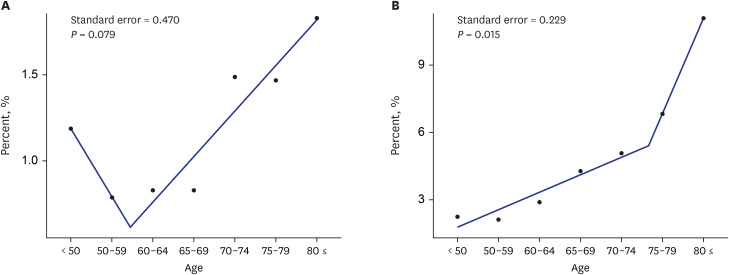
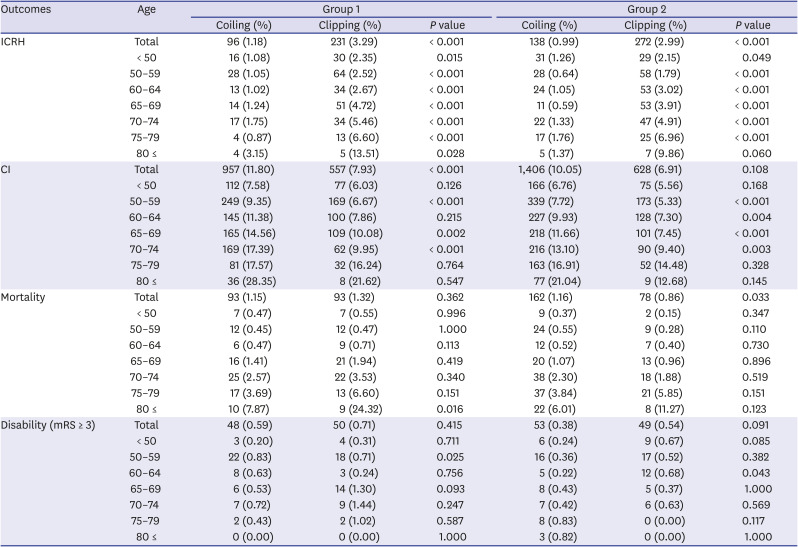
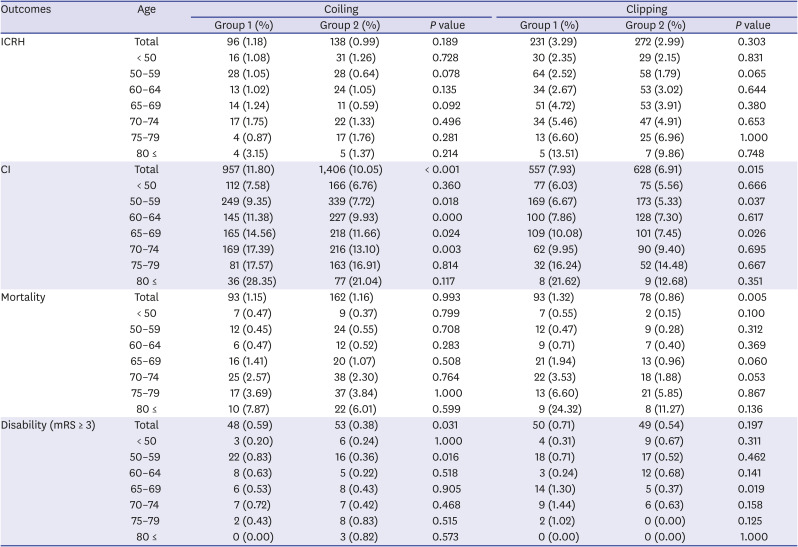




 PDF
PDF Citation
Citation Print
Print



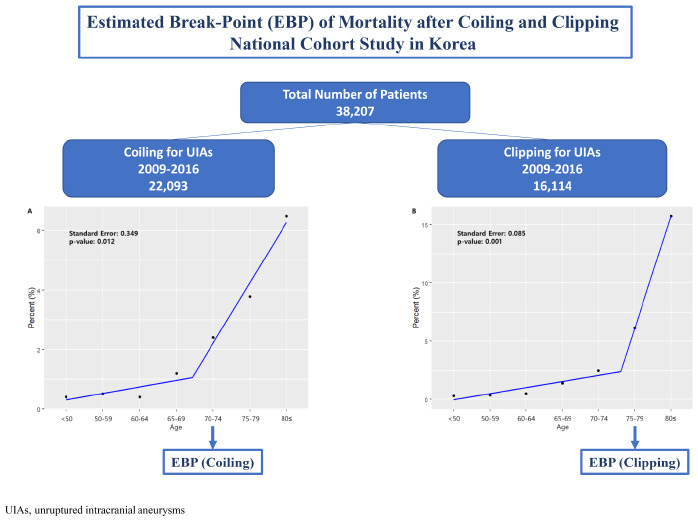
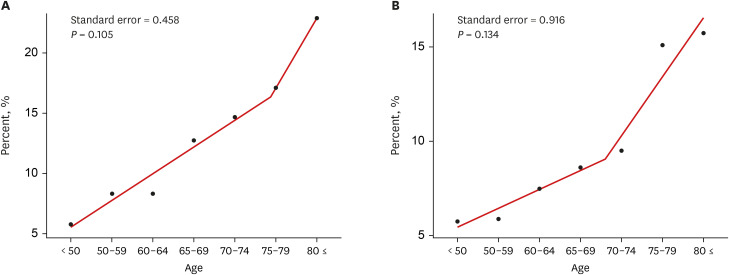
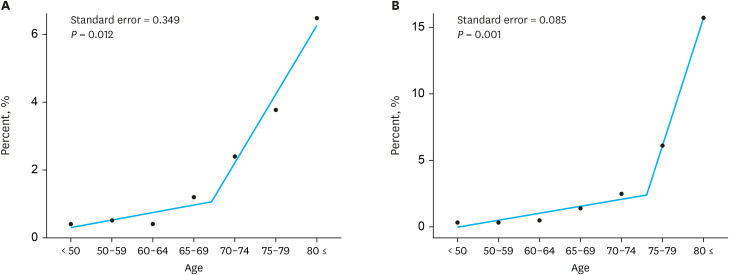
 XML Download
XML Download